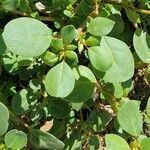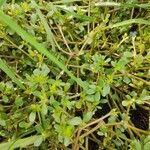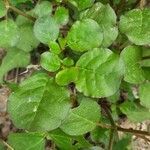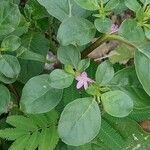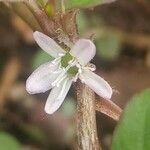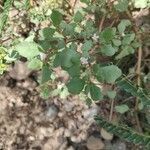Herbaceous annuals, erect or prostrate, the young stems sometimes with a decurrent line of hairs from the interpetiolar stipules to the node below and glabrescent, often alternately branched by the development of the axillary bud subtended by the smaller leaf of the nodal pair. Leaves of any pair strikingly unequal, the larger at least twice as large as the smaller, obovate to rounded-spatulate, 1-3 cm. long, 0.5-2.0 cm. broad, acute, obtuse, retuse and often mucronulate at the apex, cuneate at the base, glabrous above and below; petiole 0.3-1.5 cm. long, at the base connate into a sheath surrounding the stem, the interpetiolar stipule deltoid, 1-2 mm. long, remotely serrate or entire. Inflorescence with the flowers solitary; sessile. Flowers with the perianth tube campanulate, often intimately associated with the petiolar sheath of the subtending leaves, the lobes lanceolate, about 1.5 mm. long, 1 mm. broad, glabrous, appendage horn-like, barbed about 0.75 mm. long; stamens 10, inserted at the orifice of the perianth tube, the filaments filiform, about 1.5 mm. long, glabrous, the anthers ovoid, about 0.5 mm. long and broad; ovary turbinate, about 1 mm. long, I mm. in diameter, truncate and irregularly fleshy-lobed at the apex, glabrous, the style 1, about 1 mm. long. Capsule almost enclosed in the petiolar sheath, turbinate, about 4.5 mm. long, 3.5 mm. in diameter, sessile, truncate and crested at the apex, circumscissile at about the middle; seeds 2-5, reniform, 1.5-1.75 mm. in diameter, the testa wrinkled, reddish-brown to black.
A somewhat succulent subglabrous annual herb; stems procumbent or ascending, spreading, glabrous or sparsely hairy, up to 50 cm. long or more.. Leaves opposite, one of a pair much smaller than the other, petiolate, stipulate; blade obovate or broadly so, entire, obtuse, rounded or retuse, sometimes slightly apiculate at apex, cuneate at base, glabrous or sparsely hairy on the midrib below, 4–50 mm. long, 4–45 mm. broad.. Petiole 2–25 mm. long, distinct, sparsely hairy, expanded into a sheathing membranous base connate with that of the opposing leaf.. Stipules narrowly triangular, acuminate, up to 3 mm. long.. Flowers axillary, solitary, partly hidden by the sheathing leaf-bases, hermaphrodite, pinkish or white, 4–5 mm. long.. Stamens 10–20, inserted on the calyx-tube.. Calyx-lobes obtuse, with a dorsal apiculus.. Ovary truncate, bilobed; seeds 3–12.
Plants annual, succulent, usually glabrous. Stems prostrate or decumbent, diffusely branched, to 10 dm; young branches with lines of minute hairs proximal to petioles. Leaves: unequal pairs alternating along stem; stipules dilated at base; petiole usually equaling blade; blade elliptic to orbiculate, to 4 cm, apex obtuse, often notched, or apiculate. Inflorescences: flowers usually solitary, sessile, in axils of smaller leaves (bracts) of some pairs, partly covered by sheathing stipule of bracts; bracteoles connate, 1-1.5 mm, apex acute. Flowers: calyx 3-5 mm; calyx lobes purple adaxially, lanceolate, 2.5 mm; stamens 5-10. Capsules cylindric, ± curved, 4-5 mm, corky, basal portion appearing embedded in stem, apical portion containing 1 seed; apical wings 2, prominent, erect, crestlike. Seeds ca. 7, dull reddish brown to black, ridged, 1.5-2 mm.
Procumbent or ascending somewhat succulent herb; stems up to 50 cm or more long, glabrous or sparsely hairy. Leaves elliptic to obovate, obtuse or retuse, sometimes apiculate; lamina 4–50 mm long, 4–45 mm wide; petiole 5–25 mm long, expanded into sheath connate with opposing leaf base to form cup. Flowers solitary, sessile, largely hidden in or fused to leaf base. Perianth tube fused to leaf sheath; lobes linear to narrowly triangular, 4–5 mm long, a few hairs outside, pink or white inside. Stamens 10–20; filaments c. 2 mm long. Ovary cylindrical, style c. 2 mm long; ovules 10–15. Operculum truncate with a prominent raised denticulate rim on outer side, 2–3 mm long; perianth caducous. Seeds 3–12, 1 or 2 in operculum, others in base, reniform, c. 1.5–2 mm wide, dull black, slightly ridged.
Herbs perennial. Stems procumbent, subterete or slightly angular, glabrous or sparsely hairy when young. Petiole 4-30 mm, base expanded into sheath 2-2.5 mm; leaf blade elliptic to ovate, obovate, or obcordate, 8-50 × 4-45 mm, thinly fleshy, base cuneate, apex obtuse, retuse, truncate, or slightly acute. Flowers solitary, sessile. Perigone lobes usually 5, inside mostly pale pink, rarely white, 4-5 mm; perigone tube fused with basal sheath of pedicel, forming a funnel; lobes rather obtuse, with an apical spur. Stamens 10-25. Stigma 1, ca. 3 mm. Capsule truncate at apex, 2-lobed, operculum fleshy, base thinly walled. Seeds several, black, reniform, 1-2.5 mm, broad, with low crests. Fl. summer. 2n = 26, 28, 56.
Perennial, glabrous or sparsely hairy, diffusely branched from the base, decumbent or ascending, to 1 m; lvs round-obovate, 1–4 cm, slender-petiolate, the members of a pair somewhat unequal; fls sessile, partly concealed in the petiolar sheath; stamens 5–10; ovary unilocular, style 1; membranous hypanthium and small cal pushed off by growth of the fr; fr 4–5 mm; asymmetrically crested around the broad top; seeds 1–4, rough, 2 mm. Widespread tropical weed, extending n. to Okla. and Mo., and rarely about our Atlantic ports. May–Sept. Reputedly poisonous to livestock.
Leaves opposite, one of each pair much smaller than the other, leaf-lamina 3–45 × 3–40 mm., obovate, broadly obovate or almost circular, entire, obtuse, rounded or retuse, sometimes slightly apiculate at apex, cuneate at base, glabrous or sparsely hairy on the midrib below, petiolate, stipulate; petiole 2–20 mm. long, sparsely hairy, expanded into a sheathing membranous base connate with that of the opposing leaf; stipules up to 3 mm. long, narrowly triangular-acuminate.
A low lying smooth branched and fleshy herb. It grows each year from seed. The stems are angular. The branches are up to 60 cm long. The leaves are opposite each other and rounded at the tip but wedge shaped at the base. They are 1 to 5 cm long. The flowers are pink and the seed capsule contains about 10 small seeds.
Prostrate completely glabrous herb. Flowers solitary, ± hidden by sheathing leaf bases. Calyx tube adnate to petiole. Flowers yellowish green with pink.
A prostrate somewhat succulent annual herb, subglabrous, the young parts shortly hairy; stems up to 50 cm. or more, procumbent or ascending, spreading.
Perianth segments up to 5 mm. long, pinkish or yellowish, the tube longer than the acute lobes with a dorsal apiculus.
Flowers axillary, solitary, partly hidden by the sheathing leaf-bases.
Seeds 3–12, compressed, rounded, with “ammonite-like” markings.
Rather fleshy, almost glabrous, prostrate herb
Stamens 10–20, inserted on the calyx-tube.
Ovary truncate, 2-lobed; style 1.
Sepals pink
